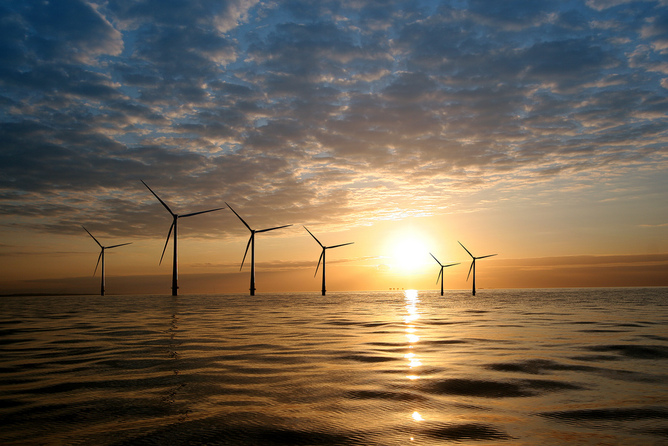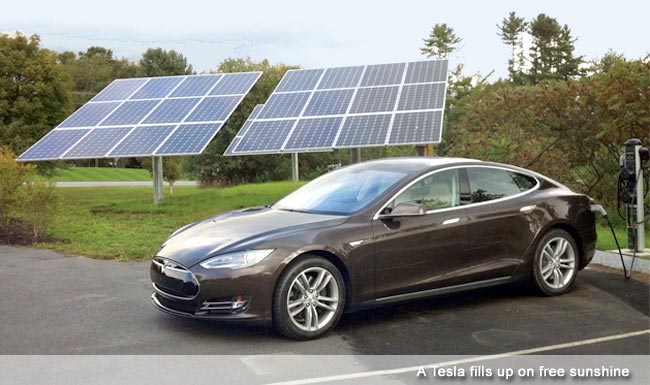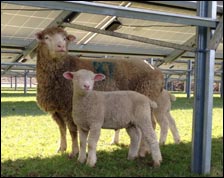The Future of Locally Generated Renewable Energy
In August 2014 Hart District Council published the Sustainability Appraisal (incorporating Strategic Environmental Assessment) of Housing Development Options. 21 development objectives were specified. If these are applied to this solar development the following objectives are met:
SA2 – To protect and enhance the health and wellbeing of the population:
The clean renewable energy generated by converting sunlight to electricity would reduce carbon emissions.
SA8 – To protect and enhance biodiversity:
The development would incorporate ecological management intended to sustain the local pollinator population that would not require artificial fertilisers.
SA9 – To protect and enhance the District’s countryside and rural landscape:
The development would continue to operate as a working farm by grazing sheep and providing a refuge for wildlife. Existing footpaths would be maintained and managed. Because the proposed development has a 25 year lifetime, when the installation came to be decommissioned the rural landscape would be restored in a form that could be eligible for organic registration status.
SA10 – To maintain and improve the water quality of the District’s rivers and groundwaters and other water bodies:
4 and 8 metre riverain margins would be maintained for wildlife and as no inorganic chemicals would be used to maintain the site the water quality would be enhanced and maintained.
SA11 – To maintain and improve soil quality:
The soil quality would be enhanced by planting and maintaining native species without the use of artificial fertiliser.
SA12 – To reduce the emissions of greenhouse gases, manage the impacts of climate change and improve air quality:
Solar energy provides all of these advantages.
SA14 – To increase energy efficiency, security and diversity of supply and the proportion of energy generated from renewable sources:
Solar arrays generate between 10 and 20 times more energy than managed arable wheat farming for a given surface area. This installation would add 9,360 MegaWatt Hours to energy generated from renewable resources within Hart.
SA15 – To promote the efficient use of land through the appropriate re-use of previously developed land:
This land has been quarried and subsequently used to tip waste. Current usage benefit is negligible.
SA16 – To improve the efficiency of resource use and achieve sustainable resource management: As SA14 and solar energy generation is a sustainable resource.
SA18 – To improve efficiency of transport networks by enhancing the proportion of travel by sustainable modes and promoting policies which reduce the need to travel:
There is the possibility of supplying the Hook conurbation with clean energy for a new generation of electric vehicles through local charging points.
Gas, Nuclear and Fracking
Of these three options gas is the cleanest. We import most of our gas from Qatar, a country with massive reserves that will last us well into the future. Ultimately gas is not sustainable but is a reliable medium term energy source for heating, manufacturing and electricity generation. The Qataris, recognising that one day their reserves will run out, know that gas is not an indefinite long term option for their economy so they are actively investing in renewable energy alternatives. In 2014 they started a joint venture with Germany's largest renewable energy company, investing $½ billion in a semiconductor wafer manufacturing facility to supply solar panel manufacturers and they have several other projects underway.
Nuclear appears to be a safe way of generating baseload electricity but contrary to what most people believe it is massively subsidised and is a downstream health risk to the next 30,000 generations. There have been several accidents at nuclear power stations, Sellafield is said to be a major contamination risk and following the Fukujima tsunami incident Japan has converted wholeheartedly to renewables. Nuclear is not a safe option and in time, unless it can be cleaned up, it will be terminated.
Fracking is the flavour of the month but there are many reports of problems in the U.S.A. With oil prices at 50% of 2014 levels it probably will not ultimately prove to be economic in the U.K. The process involves the use of carcinogenic chemicals, many of which stay underground posing a long term contamination risk, as well as large quantities of poisoned water which somehow have to be disposed of. Whilst dumping contaminated water into American rivers and the Pacific Ocean is highly unsavoury it bears no comparison to the potential effects of dumping it into Morecambe Bay or the North Sea. All things considered, fracking is a very antisocial way of extracting high carbon fossil fuel from underground rocks. As we are trying to move away from atmospheric and marine contamination it makes no sense at all to frack.
Renewable Energy
Hydroelectric power has been used for decades. Tidal and wave power are attractive solutions and offer great potential. However their operating environment is harsh and maintenance costs can be high.
Wind turbines offer the cheapest source of renewable energy even though they falsely receive a lot of bad press from the anti-renewables lobby. It is regularly claimed that they don't work when the wind isn't strong enough but the truth is that they are often temporarily switched off when grid demand is low in the same way that fossil fuel power stations reduce their output. The Big 6 energy companies are investing heavily in offshore wind because they see it as their future although they don't like to admit it while they can justify high consumer bills by claiming high gas and oil prices.

Onshore turbines are not popular because like electricity pylons, to most people they are an eyesore. They can also be noisy and present risks to birds starting and ending their migration routes.
Solar Panels
Solar panels, which are very similar to transistors, produce electricity when solar radiation (they work as soon as it gets light - they don't need bright sunshine) knocks electrons out of something called their depletion layer thus causing current to flow if they are connected into a circuit. They produce Direct Current (D.C.) electricity the same as a car battery, which is fed into a device called an inverter to convert the power into Alternating Current (A.C.) which can then be fed into the national grid. In small domestic systems; there are now over 600,000 in Britain, the electricity is commonly used in the home to power the lights, washing machines, televisions etc. and anything left over, which the householder gets paid for, is taken by the grid. Solar farms are basically the same as domestic systems but much bigger.
Once set up solar panels will work for decades as they have on the international space station for the last 40 years. After the initial cost has been amortised by electricity savings on the bill all the power generated is free. As long as the sun keeps coming up in the morning the panels keep generating. They need to be kept clean to get the maximum benefit of the sunlight but apart from that they virtually go on forever. Over 25 to 30 years their efficiency drops away as their surface is eroded by the weather and residual charges and imperfections form in their crystalline structure so that after 25 years they will only produce 90% of their original power. Solar technology is however improving all the time and recent advances in nano technology, particularly the discovery of graphene at Manchester University, indicate that there are likely to be very significant advances made in power output over the next few years. It is not entirely unlikely that a lot of the panels being installed today will be replaced by newer versions during the 25 year lifespan of a solar farm. This is what will lead to lower consumer electricity prices to the extent that one day electricity will be almost free. The Big 6 generators don't like this idea very much for obvious reasons but to put things into perspective the electrical supply industry has only been going for 100 years and it is based on obsolescent technologies and business principles so they can't expect to go on forever in their present form. Between 8% and 15% of the electricity is lost between the power station and the consumer. Long distance power line heat losses account for about 5% of this and it all has to be paid for. Year after year, every winter without fail, every major storm, power lines go down and thousands of homes lose electricity sometimes for days on end. It is absolute lunacy and it will become a thing of the past when locally generated renewable energy with local distribution comes of age.
The bottom line is that you can't fight technology advances. For example there was a lot of opposition to the motor car in Britain up to 1914 and we started the 1914/18 war with horse mounted cavalry and gas balloons. What a mistake that turned out to be. While the old school bickered in Europe the Americans were getting on with it and by 1913 Henry Ford was already building a Model T every 93 minutes. By 1925 half the cars in the world were Fords. We do seem to be determined to learn the hard way in this country.
So Where Do We Go from Here?
The main criticism of renewable energy technology to date has been its spasmodic nature. Wind turbines only work when the wind blows and solar panels only work during the hours of daylight.
To get around this problem there has been a lot of research into battery technology and we are starting to see the installation of large battery units on solar farms which store the D.C. electricity until the grid asks for it at which time it is converted to A.C. and released. Today's batteries use a variety of new storage technologies which are an improvement on the old lead acid batteries we have in our cars - and they used to have in those old slow moving milk floats. We are of course also familiar with the tiny rechargeable batteries in mobile phones and computers (did you know that you have a battery in your desktop computer?) that go on and on until you trade up to the next model.
Following the development of nano materials such as graphene and perovskite we are due for a quantum leap in battery and solar cell technology . Within a few years we will have lightweight batteries capable of charging incredibly fast, (although they may be referred to by another name such as super-capacitors) holding enough charge to propel an aluminium/carbon fibre computer controlled car - such as we already have in the form of the latest Google and Tesla cars - for 1,000 miles or more. In fact cars will have solar panels built in to their bodywork to keep the batteries permanently topped up between overnight charges. Today oil is a significant cost factor in food transport. When we eventually substitute free sunlight for oil the lower transport costs will result in today's high carbon footprint food prices falling by at least 10% at the till.

Now you can see why the oil producers are moving on to renewables production. They have the money to invest and the emerging economies have the determination and technology to manufacture at ever reducing cost. The writing is on the wall for fossil fuels, carbon pollution and high cost energy.
This is where local communities can contribute. Clean low-loss energy from local renewable sources will become the norm. Transport will be clean, silent and cost less to run. Locally air and noise pollution from the M3 will plummet to the benefit of surrounding householders and our local eco system. Household bills will fall significantly. We will all benefit simply because we have the technology to move us on from the age of high carbon fossil fuels.
The Hart District including Hook and Winchfield is now in a position to move this revolution forward. By using some of our redundant low value land we have the opportunity to pioneer a clean sustainable future for our children and grandchildren.
